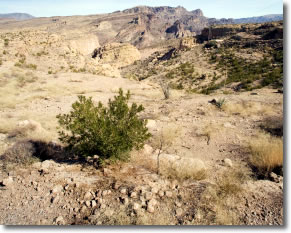THE HUMBLE CREOSOTE BUSH

Asked what the oldest plant on earth is, most people would say it’s the redwood or the bristlecone pine. And they wouldn’t be far off. Though the redwood’s average lifespan is “only” 500-700 years, under ideal circumstances it can live up to 2,000. Likewise, the bristlecone pine is an ancient species with great longevity—anywhere from 1,000 to 4,000 years. In fact, one specimen, aptly dubbed Methuselah, has been dated at 4,789 years of age. A long time in anyone’s book.
But the real winner, in terms of sheer longevity, is a far more humble, far less dramatic-looking plant: the lowly creosote bush.
Native to the American Southwest, Larrea tridentate has the interesting habit of growing in concentric rings, a fact noted by botanist Frank Vasek in the late 1970s. What is the significance of this strange adaptation? As Vasek discovered, the rings are not new plants, but instead “offshoots of a single individual.” Rather than forming rings like other plants, such as the redwoods, the creosote bush decays from the inside out, meaning that the outer rings are simply an extension of the original plant. Thus it was that using radiocarbon dating of the wood excavated from the center, Vasek and his team were able to determine that one particularly ancient creosote bush in California was 11,700 years old—almost three times the age of Methuselah.
“A scrawny plant that appears to suffer a slow starvation on the desert floor, the creosote is, in fact, a champion of survival,” stated one newspaper account of Vasek’s findings. And as Vasek himself put it, the creosote bush “hides its longevity in plain sight.”
“Hiding in plain sight,” it seems, is one of nature’s most effective tricks. It is one of God’s as well. What we seek is often right in front of our eyes, or lying, humbly and quietly, directly beneath our feet.